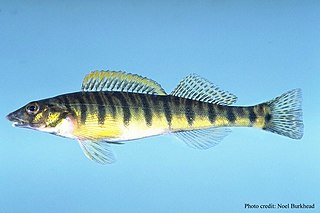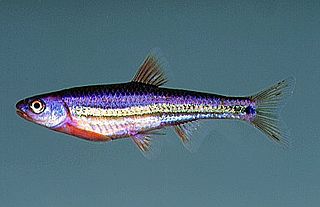
Etheostoma is a genus of small freshwater fish in the family Percidae native to North America. Most are restricted to the United States, but species are also in Canada and Mexico. They are commonly known as darters, although the term "darter" is shared by several other genera. Many can produce alarm pheromones that serve to warn nearby fish in case of an attack.

Percina is a genus of small freshwater ray-finned fish, classified within the subfamily Etheostomatinae, part of the family Percidae, which also contains the perches, ruffes and pikeperches from North America. Like the similar fishes in the genus Etheostoma, they are some species called "darters". More specifically, the genus as a whole is known as roughbelly darters, while certain species of Percina with a pattern of vertical bars on the flanks are called logperches.

Shiner is a common name used in North America for any of several kinds of small, usually silvery fish, in particular a number of cyprinids, but also e.g. the shiner perch.

Notropis is a genus of freshwater fish in the family Cyprinidae. They are known commonly as eastern shiners. They are native to North America, and are the continent's second largest genus.

Cyprinella is a genus of fish in the family Cyprinidae, the carps and minnows. They are known as the satinfin shiners. They are native to North America, and some are among the most common freshwater fish species on the eastern side of the continent. Conversely, several Cyprinella species with small distributions are threatened and the Maravillas Creek subspecies of the red shiner is extinct.

Lythrurus, the finescale shiners, is a genus of cyprinid fish found in North America. There are currently 11 species in this genus.

Madtoms are freshwater catfishes of the genus Noturus of the family Ictaluridae. It is the most species-rich family of catfish in North America, native to the central and eastern United States, and adjacent parts of Canada. Their fin spines contain a mild venom with a sting comparable to that of a honey bee.

The frecklebelly madtom is a species of fish in the family Ictaluridae endemic to the United States. Madtoms are in the genus Noturus, which is a group of catfish prevalent in North America

Luxilus is a genus of cyprinid fish found in North America. They are commonly known as highscale shiners. There are currently nine species in the genus.

The Texas shiner is a species of ray-finned fish in the genus Notropis. It is found in the Colorado River to Rio Grande drainage from Texas and northeastern Mexico and the Rio Salado and Rio San Juan systems in Mexico to the lower Pecos River in Texas.
The broadstripe shiner is a species of cyprinid fish endemic to the Chattahoochee River drainage in the states of Georgia and Alabama in the United States. It is recorded in freshwater and lives in a benthopelagic environment. The climate that they are known to be found in is temperate. The distribution of this species is within North America and in the middle Chattahoochee River drainage. They occupy clay, sand and bedrock pools of headwaters, creeks, and small rivers. It is common to find this species within the vegetation. The average length of the broadstripe shiner as an unsexed male is about 7 centimeters or about 2 inches.

The metallic shiner is a species of ray-finned fish in the genus Pteronotropis.

The mimic shiner is a species of North American cyprinid freshwater fish in the genus Notropis. The genus Notropis is commonly known as the eastern shiners. It is native to areas of the Hudson Bay drainage, Great Lakes drainage, much of the Mississippi River basin including areas of Tennessee, Virginia, North Carolina, and regions of the Gulf of Mexico extending from Mobile Bay to the drainage of Texas. However, this particular species can be found in other places such as the Atlantic Coast drainage in Connecticut and Housatonic rivers. This genus is usually characterized by almost all having a complete lateral line, 8 dorsal fin rays, a premaxillae protactile, and a silvery or speckled peritoneum. As the common name indicates, this species is difficult to classify in the wild because it looks similar to many other shiners. In fact, some even hypothesize that this species is actually a complexity of many cryptic species. While this is the case, it is important to take more caution to not misidentify this species and to understand its impact on introduced areas.

The red shiner or red-horse minnow is a North American species of freshwater fish in the family Cyprinidae. They are deep-bodied and laterally compressed, and can grow to about three inches in length. For most of the year, both males and females have silver sides and whitish abdomens. Males in breeding coloration, though, have iridescent pink-purple-blue sides and a red crown and fins.

Hybopsis is a genus of cyprinid fish endemic to the United States. There are currently six described species in this genus.
The Alabama darter is a species of freshwater ray-finned fish, a darter from the subfamily Etheostomatinae, part of the family Percidae, which also contains the perches, ruffes and pikeperches. It is endemic to the eastern United States, where it occurs mostly below the fall line of the Alabama River drainage. It is also relatively common in headwater tributaries to the Cahaba River above the fall line.
The Tombigbee darter is a species of freshwater ray-finned fish, a darter from the subfamily Etheostomatinae, part of the family Percidae, which also contains the perches, ruffes and pikeperches. It is endemic to the eastern United States, where it occurs in the Tombigbee River system in northeastern Mississippi and Alabama. It inhabits sand- and rock-bottomed pools of headwaters, creeks, and small rivers, and small streams with mixed sand-gravel substrate, and creeks with mixed sand, gravel, and hard clay or bedrock substrate. The Tombigbee darter was first formally described in 1994 by Royal Dallas Suttkus and Reeve Maclaren Bailey with the type locality given as Wolf Creek, a tributary to the Little Souwilpa Creek near Alabama State Route 17 in Choctaw County, Alabama. The specific name honors the American ichthyologist Ernest A. Lachner (1915-1996).
The Apalachee shiner is a species of cyprinid fish endemic to the southeastern United States. It is found in the Apalachicola River drainage in Georgia, Alabama, and Florida.
The orangetail shiner is a species of cyprinid fish endemic to the southeastern United States. It is endemic to in the Choctawhatchee River drainage in southeastern Alabama.
Royal Dallas Suttkus was an icthylogist and biology professor responsible for creating the Royal D. Suttkus Fish Collection, one of the largest of its kind. It houses approximately 7 million post-larval specimens of fishes. The collection is part of the Tulane University Biodiversity Research Institute and the Tulane University Museum of Natural History.














